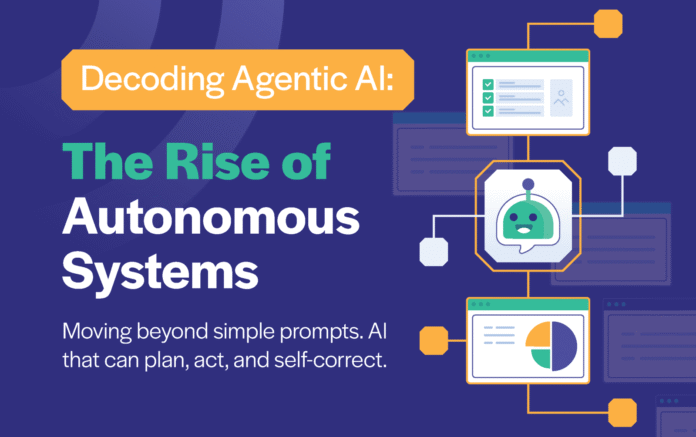Image by Editor
# Introduction
The next frontier in artificial intelligence (AI) is agentic AI, systems capable of planning, acting, and improving themselves without constant human intervention. These autonomous agents denote a shift from static models that respond to inputs to dynamic systems that think and operate independently. The infographic below illustrates what sets these agents apart, how they operate, and why they represent a foundational leap for AI. Let’s take a closer look.
![Decoding Agentic AI: The Rise of Autonomous Systems [Infographic]](https://www.kdnuggets.com/wp-content/uploads/decoding-agentic-ai-rise-autonomous-systems-infographic-kdnuggets-scaled.png)
Decoding Agentic AI: The Rise of Autonomous Systems [Infographic] (click to enlarge)
# Beyond the Chatbot: Why AI Agents Are Different
Traditional large language models (LLMs) provide one-shot answers — they process an input, produce an output, and stop there. They are great at generating text but don’t perform follow-up actions, use external tools, or adapt their approach based on results. Agentic AI changes that.
AI agents introduce multi-step autonomy: they can take a goal, plan how to achieve it, execute those steps, and summarize results. Instead of just writing a haiku or giving advice on a night out, they can research market trends, analyze data, or generate reports using a variety of tools along the way. Agentic AI makes the shift from being passive tech to active problem-solvers, capable of coordinating tasks, using APIs, and learning from outcomes.
# The Agent’s Toolkit: How Autonomous AI Thinks and Acts
At the heart of agentic AI is a modular design that attempts to mirror human cognition. The planning module — the brain — decomposes complex objectives into manageable subgoals, such as searching, reading, or extracting relevant data. It’s the agent’s reasoning engine, breaking big challenges into achievable actions.
The memory module — the notebook — acts as long-term storage, allowing agents to recall past interactions and learn from them. This memory prevents redundant work and enables iterative improvement over time. Finally, the tool use module — the hands — connects the agent to the external world, allowing it to run code, browse the web, or interact with APIs. Collectively, these modules transform a static model into a self-directed digital worker that can integrate reasoning, memory, and action.
# The Cycle of Autonomy: How Agents Self-Correct
Autonomous agents don’t just act; they adapt. Their operation follows a continuous feedback cycle: observe, plan, act, reflect. First, the agent observes the environment, collects information, and identifies goals. Then it plans a series of actions based on both memory and current context. Next, it acts by executing steps through the available tools. Finally, it reflects on the outcome, learning from successes and failures in the name of improvement.
This cycle is an attempt to mirror human problem-solving, enabling ongoing self-correction. Over time, such feedback loops create agents that become more efficient, more accurate, and more capable without explicit retraining. This continuous learning is what makes agentic AI the potential cornerstone of future intelligent systems.
# Wrapping Up
Agentic AI represents a new direction in AI development, one in which systems can operate with independence in the pursuit of their goals. As these architectuers are refined and improved upon, we’re moving closer to truly autonomous digital ecosystems capable of tackling complex, multi-layered challenges.
Download the infographic to see how these systems are built and how they redefine what “intelligent” means. Then, dive deeper into KDnuggets’ latest coverage to stay ahead of this next great transformation in AI.
Matthew Mayo (@mattmayo13) holds a master’s degree in computer science and a graduate diploma in data mining. As managing editor of KDnuggets & Statology, and contributing editor at Machine Learning Mastery, Matthew aims to make complex data science concepts accessible. His professional interests include natural language processing, language models, machine learning algorithms, and exploring emerging AI. He is driven by a mission to democratize knowledge in the data science community. Matthew has been coding since he was 6 years old.
